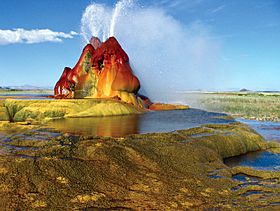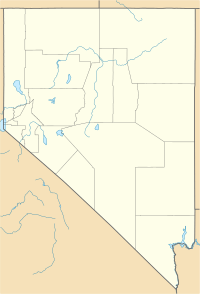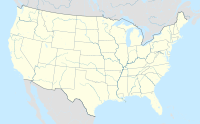Fly Geyser facts for kids
Quick facts for kids Fly Geyser |
|
|---|---|
 |
|
| Name origin | Named after Fly Ranch |
| Location | Fly Ranch, Washoe County, Nevada |
| Coordinates | 40°51′34″N 119°19′55″W / 40.85944°N 119.33194°W |
| Elevation | 4,014 feet (1,223 m) |
| Type | Cone-type geyser |
| Eruption height | 5 feet (1.5 m) and growing |
| Frequency | Constant |
| Duration | Constant |
| Temperature | 93.0 °C (199.4 °F) |
Fly Geyser, also known as Fly Ranch Geyser, is a small, amazing geyser in Washoe County, Nevada. It's located on private land called Fly Ranch, about 20 miles (32 km) north of Gerlach. This unique geyser sits near the edge of Fly Reservoir. The entire mound it rests on is about 5 feet (1.5 m) high and 12 feet (3.7 m) wide.
In June 2016, the non-profit Burning Man Project bought the 3,800 acres (1,500 ha) Fly Ranch. This purchase included the geyser itself, costing $6.5 million. The Burning Man Project started letting people visit the property in May 2018. The geyser is home to special tiny living things called thermophilic algae. These algae love hot, wet places and make the rocks around the geyser glow with bright green and red colors.
Contents
Where is Fly Geyser Located?
Fly Geyser is found on the large Fly Ranch property. This ranch is in an area called Hualapai Flat. The geyser is only about 0.3 miles (0.48 km) from State Route 34. It's also about 25 miles (40 km) north of the town of Gerlach, Nevada. If you look to the east, you'll find the famous Black Rock Desert.
How Fly Geyser Was Formed
The heat for Fly Geyser comes from very hot rocks deep underground. This area has many cracks and shifts in the Earth's crust.
The first geyser at this spot appeared in 1916. This happened when people drilled a well to find water for farming. Instead, they found very hot geothermal water, almost boiling! The well was then left alone. Over time, a cone made of calcium carbonate grew about 10–12-foot (3.0–3.7 m) tall.
In 1964, a company drilled a second well nearby. They were looking for hot water to make energy. However, the water wasn't hot enough for their plans. They tried to seal the well, but the seal broke. Water from this new well started flowing out. This new flow caused the first geyser to dry up. Minerals like calcium carbonate and silica from the water built up. These minerals created the colorful cones and pools we see around the new geyser today.
The geyser now has several cone-shaped openings. These cones sit on a large mound. The cones themselves are about 6 feet (1.8 m) tall. The entire mound, including the cones, stands 25 to 30 feet (7.6 to 9.1 m) high.
What Makes Fly Geyser Special?
The water coming out of the geyser is very hot. Its temperature can be over 200 °F (93 °C). This is normal for geysers that are located high up.
Carolina Muñoz Saez is a scientist who studied the geyser. She was hired by the Burning Man owners. She found that the geyser's water has a lot of silica. This silica, along with the hot temperature, makes quartz form very quickly inside the geyser. Usually, quartz takes up to 10,000 years to grow in geysers. Saez said Fly Geyser is different from any other geyser she has studied.
Water constantly shoots out of the geyser. It can reach up to 5 feet (1.5 m) into the air. The geyser has also created many travertine terraces. These terraces form 30 to 40 pools. They spread out over an area of 74 acres (30 ha). The water from the geyser contains thermophilic algae. These tiny living things thrive in hot, wet places. They are what give the rocks their bright green and red colors.
How Can You Visit Fly Geyser?
Fly Ranch is open for small, guided nature walks. These walks are offered from April to October each year. Each walk lasts about three hours. The geyser is a main part of these nature walks. The tours are managed and led by a group called Friends of Black Rock-High Rock.
When you pay for tickets for a walk, it's considered a donation. These donations help support Fly Ranch and the Friends organization.
Other Geysers Nearby
Before the current Fly Geyser, another geyser was created in 1917. This also happened because of a well-drilling attempt. It formed a tall pillar of calcium carbonate about 12 feet (3.7 m) high. However, this older geyser stopped flowing when the main Fly Geyser started releasing water in 1964.
See also
 In Spanish: Géiser Fly para niños
In Spanish: Géiser Fly para niños




